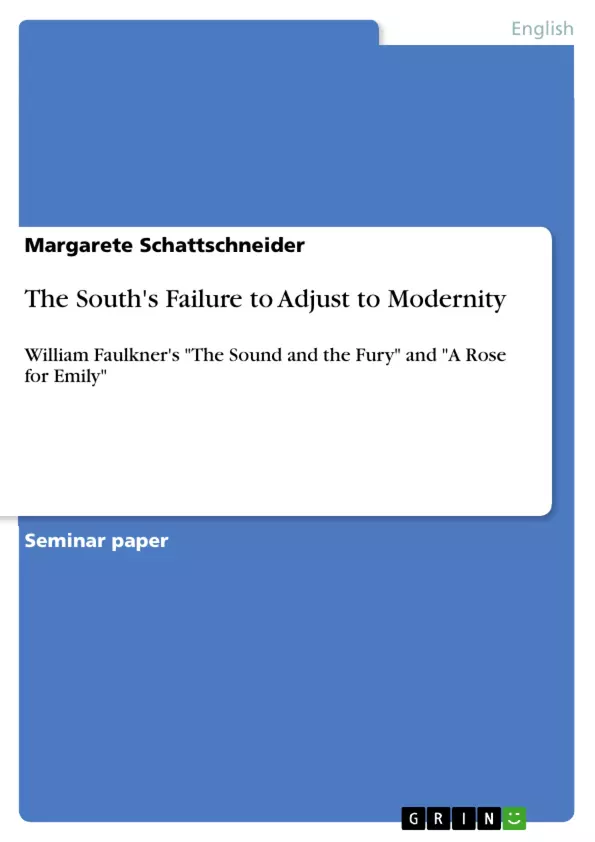Introduction:
The South, particularly the rural South, was a central aspect in Faulkner’s writings, for he belonged to the South himself. He even constructed a fictitious country, commonly known as Yoknapatawpha, which provides the setting of numerous of his stories. It served as a lens through which he could examine the traditions, practices and attitudes that had divided and united the people of the South. Faulkner was mostly interested in exploring the moral allusions of history. As the South emerged from the Civil War and Reconstruction period, the people were often torn between a new and an older, more established world order. Most of the time, the culture of the South was “inward-turning”, “backward-looking” and “frozen in its virtues” (Warren 244). This offered an image of massive immobility, while people were fixed on moral values and gentility at the same time. Faulkner wrote about this unchangeableness and ideas of Southern gentility, in a sometimes sarcastic way. He literally attacked the way of thinking by introducing a modern writing style, which included complex and heavily loaded sentences, as well as the “stream-of-consciousness” technique that disregards chronology of events. Thus, why did the South fail to adjust to modernity?
The Sound and the Fury is considered to be an absolute classic of modernity. In this paper, Faulkner’s novel The Sound and the Fury and the short story “A Rose for Emily” will be analysed, searching for reasons to the problem of adjusting to modernity. Therefore, I will look at the depiction of the main characters and indications of role reversal with regard to the ideal Southern family. Furthermore, Quentin’s fixation on the past, as well as Caddy’s and Miss Quentin’s rebellion against the present will be examined. Finally, a closer look at the main characters’ experiences of loss in The Sound and the Fury will take place. The novel, in its struggle with modernity is similar to the short story “A Rose for Emily” and will be set in contrast to it. Apart from the depiction of the main characters, the theme of tradition versus change as an allegory of the South plays an important role.
This study, however, is only a small glimpse into a very wide subject, which could be investigated so much longer.
Inhaltsverzeichnis (Table of Contents)
- I. Introduction
- II. The Struggle with Modernity in The Sound and the Fury
- 2.1 About the novel
- 2.2 Depiction of Characters
- 2.3. Role Reversal
- 2.4 Fixation on Southern values: Quentin
- 2.5 Rebellion Against the Present: Caddy and Miss Quentin
- 2.6 Feelings of Loss
- III. The Struggle with Modernity in "A Rose for Emily"
- 3.1 About the short story
- 3.2 Depiction of characters
- 3.3 Tradition vs. Change - an Allegory of the South
- IV. Conclusion
Zielsetzung und Themenschwerpunkte (Objectives and Key Themes)
This paper aims to analyze Faulkner's novel The Sound and the Fury and the short story "A Rose for Emily" in the context of the South's struggle to adapt to modernity. It examines the depiction of characters, the impact of role reversal, and the complexities of the past and present within the Southern family. The paper also explores themes of tradition vs. change, the consequences of loss, and the enduring significance of Southern values.
- The impact of modernity on Southern society
- The complexities of family dynamics and role reversals
- The struggle with the past and its influence on the present
- The themes of tradition vs. change and the legacy of Southern values
- The exploration of loss and its impact on individual characters
Zusammenfassung der Kapitel (Chapter Summaries)
The introduction provides an overview of Faulkner's interest in the South and his exploration of its cultural and social complexities in the context of the post-bellum era. The main themes of the paper are outlined, focusing on the novel The Sound and the Fury and the short story "A Rose for Emily."
The second section delves into the complexities of modernity in The Sound and the Fury, analyzing the novel's depiction of the Compson family. This section explores themes of family dysfunction, declining fortunes, and the impact of outdated values on individual characters. It examines the characters' struggles with the past, their inability to adapt to the present, and the consequences of loss. The section further highlights the role reversal between white and black characters, presenting the black family as embodying strength and resilience in contrast to the white family's fragility.
The third section continues the analysis of modernity in Faulkner's work, but shifts focus to the short story "A Rose for Emily." This section explores the theme of tradition vs. change through the lens of the Southern past and its enduring influence on the present. It analyzes the story's depiction of characters and their relationships to societal expectations and the weight of history.
Schlüsselwörter (Keywords)
The main keywords and themes of the paper include: Faulkner, Southern literature, The Sound and the Fury, A Rose for Emily, modernity, tradition vs. change, family dynamics, role reversal, loss, Southern values, decline, and the South's post-bellum era.
- Quote paper
- Margarete Schattschneider (Author), 2011, The South's Failure to Adjust to Modernity, Munich, GRIN Verlag, https://www.grin.com/document/177147



